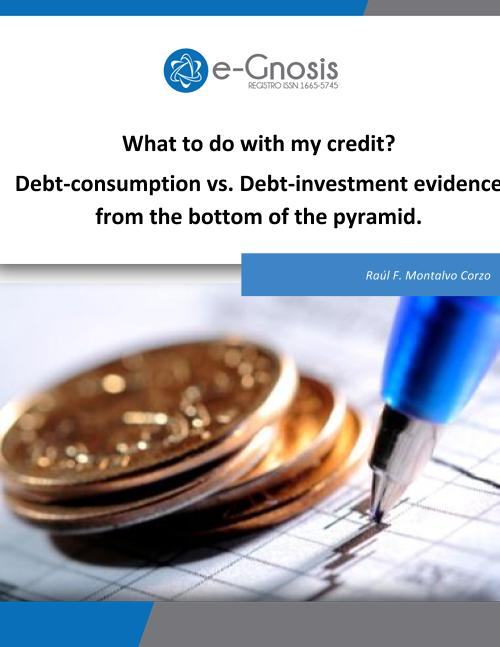What to do with my credit? Debt-consumption vs. Debt-investment evidence from the bottom of the pyramid.
Palabras clave:
Low income groups, credit usage, consumption decisions, investment decisionsResumen
This paper analyzes the use of money from a credit by low-income individuals, the so-called base of the pyramid. In addition, differences in terms of socioeconomic profiles and their effect over their behavior when it comes to credit use is analyzed. On the first hand side, a choice can be to use the money from a credit for investment purposes that may create opportunities for producing and generating revenue. This situation is called debt-investment and it is argued that it only happens under particular conditions. Additionally, there is an alternative category proposed, called debt-consumption, where the credit can be used to purchase goods and services that do not have direct productive uses. The result of the debt-consumption category has led to the emergence of many business models that use credit to promote consumption. These arguments are tested statistically on a sample in low income areas of Guadalajara, Mexico. The results show after adding some socioeconomic variables that people is more willing to consume than to invest.
Citas
Scheiner, M. (2003). A cost-Effectiveness Analysis of the Grameen Bank of Bangladesh. Development Policy Review, 21(3), 357-382.
Aslanbeigui, N., Oakes, G. and Uddin N. (2010). Assessing Microcredit in Bangladesh: A critique of the concept of empowerment. Review of Political Economy, 22(2), 181-204.
Woolcock, M. (1999). Learning from failures in Microfinance: What unsuccessful cases tell us about how group-based programs work. American Journal of Economics and Sociology, 58(1).
Cull, R., Demirguc-Kunt, A. and Morduch, J. (2009). Microfinance Meets the Market. Journal of Economic Perspectives, 23(1), 167-192.
London, T. (2009). Making better investments at the Base of the Pyramid. Harvard Business Review. 87(5), 106-113.
Richins, M. (2011). Materialism, Transformation Expectations, and Spending: Implications for Credit Use. Journal of Public Policy & Marketing; Fall2011, 30(2), 141-156.
Richins & Dawson (1992). Introduction. In Ataur, R. Consumer credit as lifestyle activities facilitators for consumers of Bangladesh. International Journal of Marketing Studies, 1(2), 114- 126.
Khavul, S. (2010). Microfinance: Creating Opportunities for the Poor? Academy of Management Perspectives.
Ataur, R. (2009). Consumer credit as lifestyle activities facilitators for consumers of Bangladesh. International Journal of Marketing Studies, 1(2), 114- 126.
Bolton, L., Bloom, P. & Cohen, J.(2011). Using Loan Plus Lender Literacy Information to Combat One-Sided Marketing of Debt Consolidation Loans. International Journal of Marketing Studies, 48(1), 55.
Asociación Mexicana de Agencias de Investigación de Mercado y Opinión Pública, A.C. (2009), “Los Niveles Socieconómicos y la distribución del gasto”. Retrieved from http://www.amai.org/NSE/NivelSocieconomicoAMAI.pdf.
Voss, K., Spangerber, E. & Grohmann, B. (2003). Measuring the Hedonic and Utilitarian Dimensions of Consumer Attitude. Journal of Marketing Research, 1(2), 310- 320.
Sachs, J. (2005). The End of Poverty: Economic Possibilities for Our Time. Penguin Books New York.
Egli, D. (2004). Progressive Lending as an Enforcement Mechanism in Microfinance Programs. Review of Development Economics, 8(4), 202-520.
Chant, S. (2003). Female household headship and the feminisation of poverty: facts, fictions and forward strategies. New Working Paper Series, Issue 9, ISSN:1470-8515. Gender Institute, London School of Economics and Political Science, London, UK.
Kumar, S. & Kumar, R. (2010). Motivating Women Entrepreneurs in Orissa: An Enquiry into its Dynamics in a Comparative Setting. Vilakshan, XIMB Journal of Management, 123- 140.
Moon, U. (2011). Role of Self Help Group- Bank Linkage Model in Women Empowerment. Asia Pacific Journal of Research in Business Management, 2(6).
Coley, A. & Burgess, B. (2003). Gender differences in cognitive and affective impulse buying. Journal of Fashion Marketing and Management, 7(3), 282-295.
Tifferet, S. & Herstein, R. (2012). Gender differences in brand commitment, impulse buying, and hedonic consumption. Journal of Product & Brand Management. 21(3). 176-182.
Matin, I. (2002). Finance for the poor: from Microcredit to Microfinancial Services. Journal of International Development. March 2002. 14, 273-294.
Wang, H. (2006). Consumption of Debt: An Interpersonal Relationship Approach. (Dissertation to the Faculty of the Committee on Business Administration). University of Arizona.
Gehlich-Shillabeer, M. (2008) Poverty alleviation or poverty traps? Microcredit and vulnerability in Bangladesh. Disaster Prevention and Management, 17(3), 396-409. Emerald Group Publishing.
Hoque, S. (2004). Micro-credit and the Reduction of Poverty in Bangladesh. Journal of contemporary Asia, 34(1).
Cons, J. & Paprocki, K. (2008). The Limits of Microcredit—A Bangladesh Case. Food first Backgrounder, 14(4).






